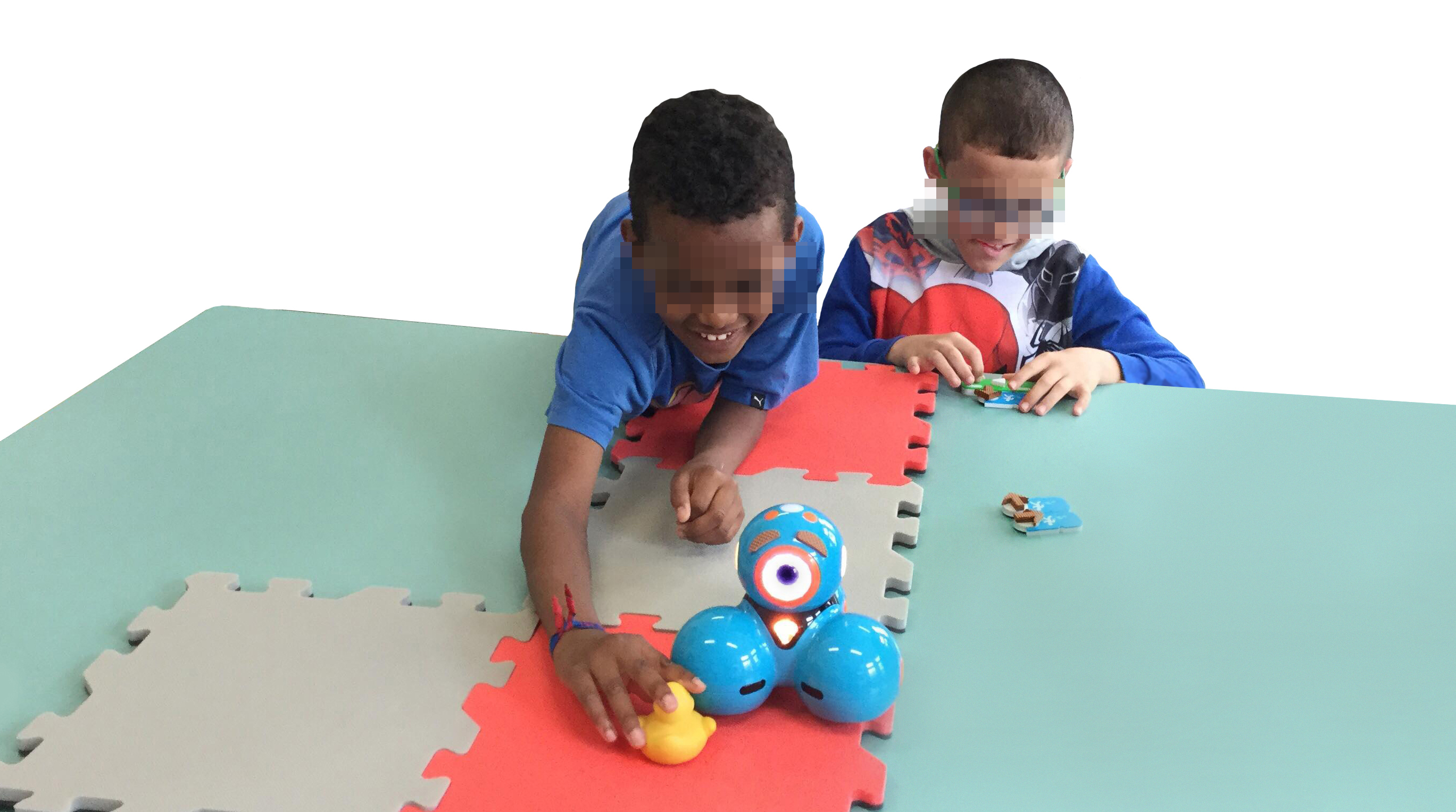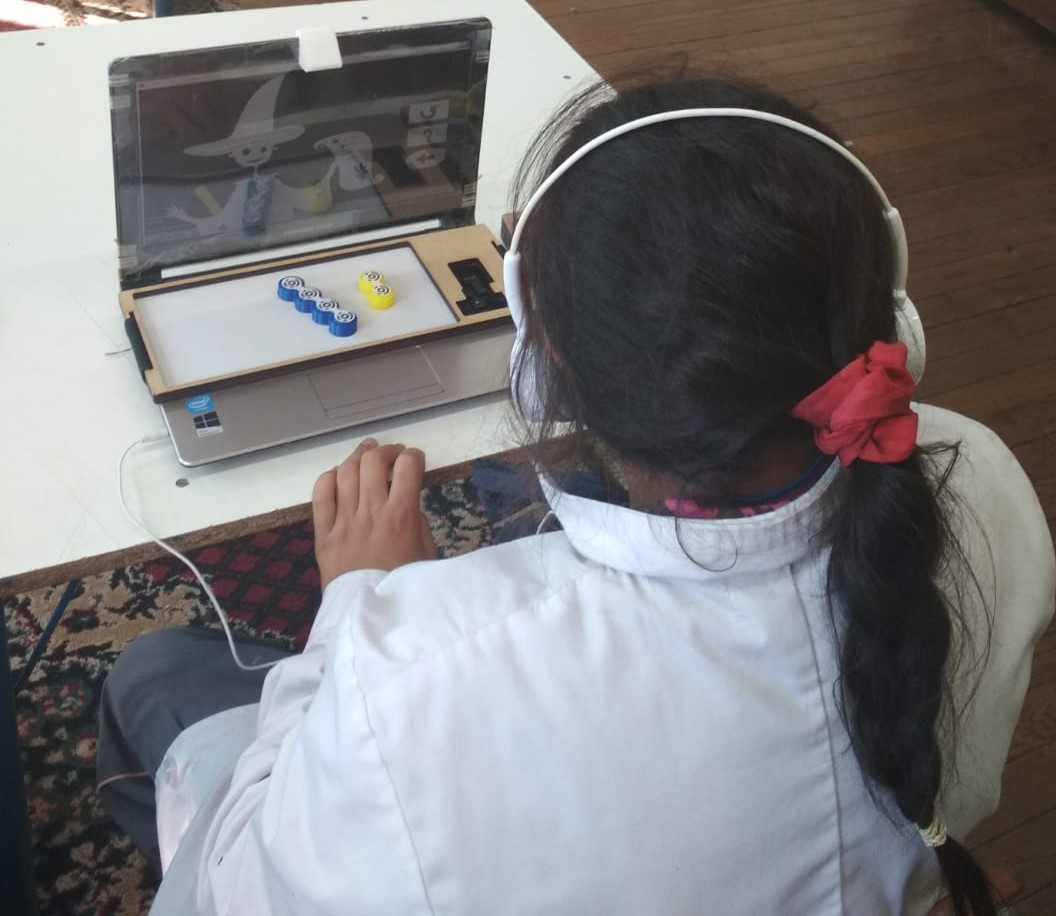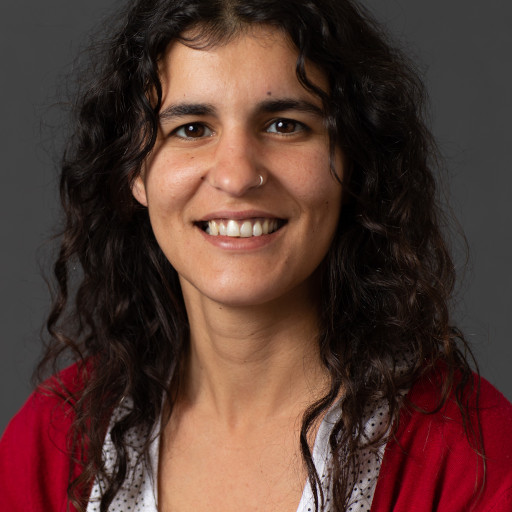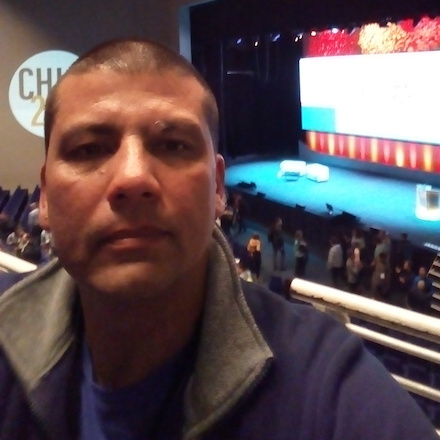Inclusive education
We aim to develop technological solutions to enable an inclusive education for children with mixed abilities. We have mainly developed enhanced tangible objects for the acquisition of abstract concepts, such as mathematics or computational thinking. Besides the benefit of decreasing cognitive load and reinforcing understanding, manipulatives also support collaboration, making children more prone to divide, explore and share supporting cooperative actions.
Computational Thinking learning for young visually impaired children
Promoting CT has been increasingly performed with programming activities. The advent of visual programming environments, like Scratch or Blockly, democratized programming in schools. The use of tangible blocks has also been extensively used as a way to facilitate understanding of abstract concepts, reduce cognitive load, and promote CT, while simultaneously developing motor, perceptual and cognitive abilities. Programming a robot, with these environments (virtual or tangible), is another trend that increases the physicality of the programming output, and provides a greater sense of control. However, these approaches and artifacts they are not accessible to children with visual impairments. We extended prior work on accessible programming environments by taking a principled approach that builds on established knowledge and explores opportunities for inclusion, in a classroom environment. Our studies highlighted that it is achievable and affordable to create inclusive tangible robot-based programming environments and activities. The augmented physicality of robots, blocks, and maps showed to be promising to provide a layer of inclusion to children with visual impairments. Similarly, increased and consistently designed (audio) feedback and feedforward mechanisms are pivotal to potentiate concept acquisition and enable a faster learning curve. The layers added to include children with visual impairments, most with multiple comorbidities, seem to be amenable to most of the available tangible programming environments.

Math learning for young visually impaired children
We developed iCETA, an inclusive interactive system for math learning, that enables children to autonomously engage and solve additive composition tasks. It was designed through a set of participatory sessions with visually impaired children and their educators, and supports math learning through the combination of tangible interaction with haptic and auditory feedback. Tangible blocks representing numbers 1 to 5 were used to add or subtract and correctly solve the task embedded in a computerized game. Our approach aims to provide better scaffolding for understanding the abstract concept of a number by working with different representations of that number, such as the size of a block, Braille, color and audio feedback.

Publications
-
Exploring Collaboration in Programming Activities with Children with Visual Impairments: a 10-Session Study in a School Setting
Filipa Rocha, David Gonçalves, Ana Cristina Pires, Hugo Nicolau, Tiago Guerreiro
ACM Conference on Computer-Supported Cooperative Work and Social Computing, October, 2025 -
Workspace Awareness for Mixed-Visual Ability Children Collaborating in Tangible Programming Activities
Filipa Rocha, Hugo Simão, João Nogueira, Isabel Neto, Tiago Guerreiro, Hugo Nicolau
ACM Conference on Human Factors in Computing Systems, April, 2025 -
Ethical Concerns when Working with Mixed-Ability Groups of Children
Ana Henriques, Patrícia Piedade, Filipa Rocha, Isabel Neto, Tiago Guerreiro, Hugo Nicolau
26th International ACM SIGACCESS Conference on Computers and Accessibility, October, 2024 -
Inclusive Computational Thinking in Public Schools: A Case Study from Lisbon
Ana Pires, Filipa Rocha, Tiago Guerreiro, Hugo Nicolau
ACM Interactions Magazine, July-August, 2024 -
TACTOPI: Exploring Play with an Inclusive Multisensory Environment for Children with Mixed-Visual Abilities
Ana Pires, Lúcia Abreu, Filipa Rocha, Hugo Simão, João Guerreiro, Tiago Guerreiro, Hugo Nicolau
ACM Interaction Design and Children, June, 2023 -
Coding Together: On Co-located and Remote Collaboration between Children with Mixed-Visual Abilities
Filipa Rocha, Filipa Correia, Isabel Neto, Ana Pires, João Guerreiro, Tiago Guerreiro, Hugo Nicolau
ACM Conference on Human Factors in Computing Systems, April, 2023 -
Current Practices in Teaching Computational Thinking to Children: Accessibility is an Afterthought
Marta Carvalho, Filipa Rocha, João Guerreiro, Hugo Nicolau, Tiago Guerreiro, Ana Pires
Co-designing with Mixed-ability Groups of Children to Promote Inclusive Education, 2022 -
Co-Designing with Mixed-Ability Groups of Children to Promote Inclusive Education
Ana Pires, Isabel Neto, Emeline Brulé, Laura Malinverni, Oussama Metatla, Juan Pablo Hourcade
ACM Interaction Design and Children (IDC) Conference -
Learning Maths with a Tangible User Interface: Lessons Learned through Participatory Design with Children with Visual Impairments and Their Educators
Ana Cristina Pires, Ewelina Bakala, Fernando Gonzalez-Perilli, Gustavo Sansone, Bruno Fleischer, Sebastian Marichal, Tiago Guerreiro
International Journal of Child-Computer Interaction -
Fostering Collaboration with Asymmetric Roles in Accessible Programming Environments for Children with Mixed-visual-abilities
Filipa Rocha, Guilherme Guimarães, David Gonçalves, Ana Cristina Pires, Lúcia Abreu, Tiago Guerreiro
ACM Conference on Computers and Accessibility -
Accembly at Home: Accessible Spatial Programming for Children with Visual Impairments and their Families
Filipa Rocha, Ana Pires, Isabel Neto, Hugo Nicolau, Tiago Guerreiro
ACM Interaction Design and Children, June, 2021 -
LEGOWorld: Repurposing Commodity Tools and Technologies to Create an Accessible and Customizable Programming Environment
Gonçalo Cardoso, Ana Pires, Lúcia Abreu, Filipa Rocha, Tiago Guerreiro
Extended Abstracts of the ACM Conference on Human Factors in Computing Systems, May, 2021 -
TACTOPI: a Playful Approach to Promote Computational Thinking for Visually Impaired Children
Lúcia Abreu, Ana C. Pires, Tiago Guerreiro
ACM Conference on Computers and Accessibility -
Exploring Accessible Programming with Educators and Visually Impaired Children
Ana Cristina Pires, Filipa Rocha, António Barros, Hugo Simão, Hugo Nicolau, Tiago Guerreiro
ACM Interaction Design and Children -
A Tangible Math Game for Visually Impaired Children
Ana Cristina Pires, Sebastian Marichal, Fernando Gonzalez-Perilli, Ewelina Bakala, Bruno Fleischer, Gustavo Sansone, Tiago Guerreiro
21th International ACM SIGACCESS Conference on Computers and Accessibility. Pittsburgh, PA, USA. October, 2019 -
Building blocks of mathematical learning: digital and tangible manipulatives lead to different strategies in number composition
Ana Cristina Pires, Fernando González Perilli, Ewelina Bakała, Bruno Fleisher, Gustavo Sansone and Sebastián Marichal
Educational Psychology, 2019



